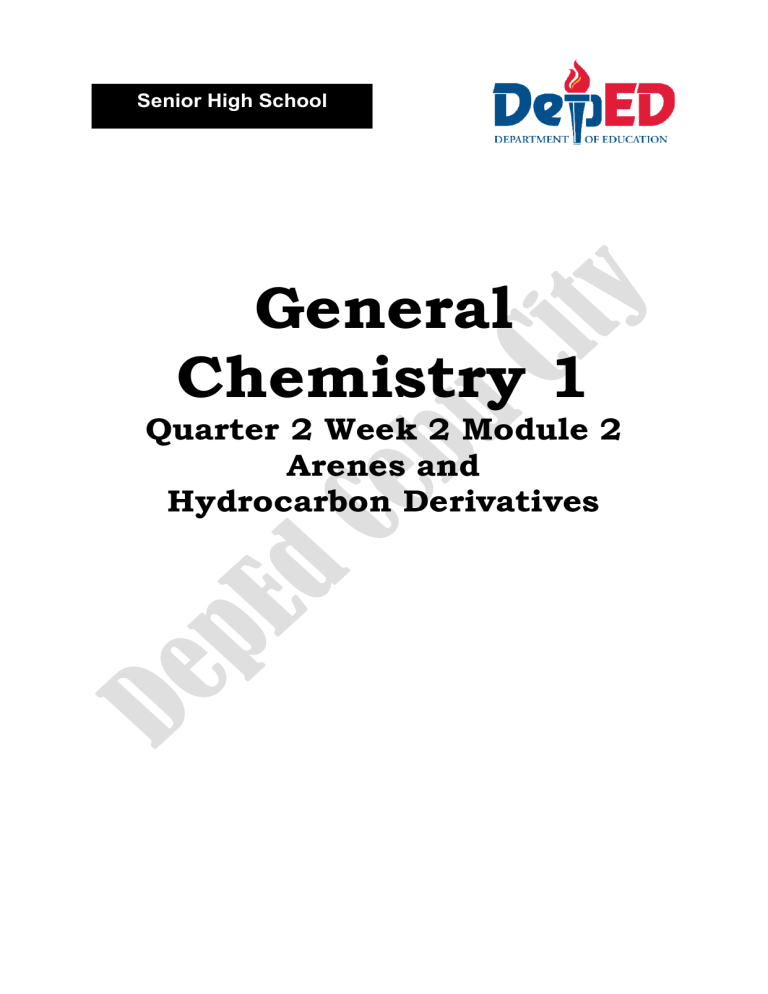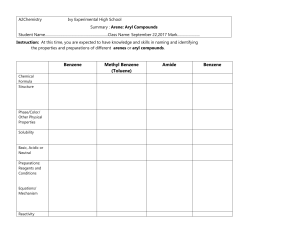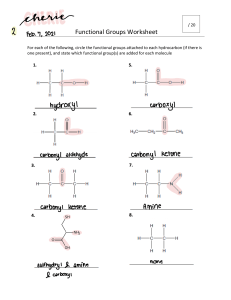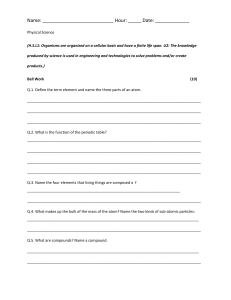
Senior High School General Chemistry 1 Quarter 2 Week 2 Module 2 Arenes and Hydrocarbon Derivatives General Chemistry 1 – Grade 11 Alternative Delivery Mode Quarter 2 Week 2 Module 2: Arenes and Hydrocarbon Derivatives 2nd Edition 2021 Republic Act 8293, section 176 states that: No copyright shall subsist in any work of the Government of the Philippines. However, prior approval of the government agency or office wherein the work is created shall be necessary for exploitation of such work for profit. Such agency or office may, among other things, impose as a condition the payment of royalties. Borrowed materials (i.e., songs, stories, poems, pictures, photos, brand names, trademarks, etc.) included in this module are owned by their respective copyright holders. Every effort has been exerted to locate and seek permission to use these materials from their respective copyright owners. The publisher and authors do not represent nor claim ownership over them. Published by the Department of Education Secretary: Leonor Magtolis Briones Undersecretary: Diosdado M. San Antonio Development Team of the Module Developer / Compiler: Dinna G. Carangue Language Editor: Roquesa B. Sabejon, PSDS North District VII Content Editors: Celia C. Gepitulan, Principal I, Regino Mercado Night High School Bonnie James A. Saclolo, Teacher III, Cebu City National Science High School Jocelyn C. Butanas, Master Teacher I, Talamban National High School Rey Kimilat, Head Teacher V, Abellana National School Management Team: RHEA MAR A. ANGTUD, Ed.D., Schools Division Superintendent BERNADETTE A. SUSVILLA, Ed.D., Asst. Schools Division Superintendent GRECIA F. BATALUNA, CID Chief RAYLENE S. MANAWATAO, EPSvr – Science VANESSA HARAYO LLB, EPSvr – LRMS Printed in the Philippines by DepEd Cebu City Department of Education – Region VII Office Address: Telephone No.: E-mail Address: New Imus Road, Barangay Day-as, Cebu City (032) 253 2559 cebu.city@deped.gov.ph What I Need to Know This module was designed and written with you in mind. It is here to help you master the nature of Chemistry. The scope of this module permits it to be used in many different learning situations. The lessons are arranged to follow the standard sequence of the course. The module consists of one lesson, namely: • Lesson 1 – Arenes and Hydrocarbon Derivatives After going through this module, you are expected to: 1. write names and formulas for simple arenes 2. describe the different functional groups (STEM_GC11OCIIg-j-87) 3. identify the functional group in each of the following: organic halide, alcohol, phenol, ether, amine, aldehyde, ketone, carboxylic acid, ester and amide. What I Know I. Choose the letter of the correct answer. Write your answers in a separate sheet of paper. 1. Cortisone belongs to ________ group. A. aldehyde B. amide C. ester D. ketone 2. Methylacetate belongs to the class of _________. A. aldehyde B. amide C. ester D. ketone 3. What is the name of the following compound? A. 1, 2-dimethylbenzene B. meta-xylene C. ortho-xylene D. para-xylene For numbers 4 to 7, identify the class of compound for the given hydrocarbon derivative based on its structure. 4. A. alcohol B. ester C. ether D. organic halide A. aldehyde B. amide C. amine D. ether A. alcohol B. aldehyde C. amide D. amine 5. 6. 7. A. alcohol B. carboxylic acid C. ester D. ether 8. The general formula for amines is _________. A. R-CH2 B. R2CH C. R-NH2 D. R-COOH 9. Compounds in which one hydrogen atom of an alkane is substituted by one halogen atom are called _______. A. ethers B. phenols C. alcohols D. organic halides 10. A _________ is characterized by the presence of the -OH group attached to a hydrocarbon chain. A. ether B. phenol C. alcohol D. organic halide 11. The general formula for carboxylic acids is _______. A. R-OH B. R-O-R C. R-NH2 D. R-COOH 12. Hydrocarbons and their derivatives are called ________. A. isomers C. organic compounds B. isotopes D. inorganic compounds 13. Groups of atoms that can occur within organic molecules are called ________. A. alkane groups C. functional groups B. cyclic compounds D. homologous groups 14. A group of atoms obtained by removing one hydrogen atom from an alkane is a/an __________. A. alkene B. alkyne C. alkyl group D. functional group 15. ____________ is an example of ester. A. C. B. D. Lesson 1 Arenes and Hydrocarbon Derivatives What’s In In the previous module, we have already been acquainted with alkyl groups. In this lesson, we will revisit alkyl groups and become familiar with another kind of substituent in organic chemistry – the aryl groups. Such will then be followed by the topic on arenes or aromatic hydrocarbons. These are unsaturated hydrocarbons that have one or more planar six-carbon rings called benzene rings to which hydrogen atoms are attached with the general formula C nHn. Lastly, we shall deal with hydrocarbon derivatives which are offshoots of hydrocarbons. What’s New The stamp at the right commemorates Kekulé’s proposal for the cyclic structure of benzene in 1865. Benzene, a molecule with the chemical structure of C6H6, has a molar mass of just over 78 grams/mole. At room temperature, benzene tends to exist in a liquid state. It is colorless and has a very distinctive gasoline-like Figure 2.1. August Kekulé stamp odor. Benzene is soluble in water and has a (Source: Corwin, C. H. (2018). Introductory Chemistry Concepts and Critical Thinking melting point of 5.33 degrees Celsius. It also 8th ed. USA: Prentice Education, Inc.) has a boiling point of 80.1 degrees Celsius. This aromatic hydrocarbon is also highly flammable. It is carcinogenic and tends to be used as an additive to gasoline, plastics, synthetic rubbers, dyes, and industrial solvents. It is also the parent compound for numerous other aromatic compounds. What is It Alkyl and Aryl Groups When a hydrogen atom is removed from an alkane, an alkyl group (symbol R-) results. Because an alkyl group is missing a hydrogen atom, it can bond to another atom or molecule. The name of the alkyl group is formed by changing the suffix -ane of the alkane to the suffix -yl. For example, methane becomes a methyl group. Similarly, removing a hydrogen atom from ethane gives an ethyl group. Removal of a hydrogen atom from propane can occur in two ways—from the end of the molecule or from the middle carbon atom. The structural formula of propane, CH3–CH2–CH3, shows that there are six hydrogen atoms on the end carbons and two hydrogen atoms on the central carbon. Since the end carbon atoms are identical, we can remove any one of the six hydrogen atoms to produce a propyl group. Since the middle two hydrogen atoms are equivalent, we can remove either of these atoms to form an isopropyl group. It is easy to see that we can substitute a chlorine atom onto a propane molecule at two different positions. If the chlorine is attached to an end carbon, the result is “propyl chloride,” CH3–CH2–CH2–Cl. If the chlorine atom is attached to the central carbon, the result is “isopropyl chloride,” CH 3–CH(Cl)–CH3. “Propyl chloride” and “isopropyl chloride” are isomers, and thus have different properties. When a hydrogen atom is removed from an aromatic hydrocarbon, the result is an aryl group (symbol Ar – ). The most common aryl group results from removal of a hydrogen atom from a benzene ring. The resulting aryl group is called a phenyl group. Now, let us summarize the structures of alkyl groups. The names and formulas of selected alkyl and aryl groups are shown in Table 2.1. Table 2.1 Alkyl and Aryl Groups Arenes In 1825, the English scientist Michael Faraday (1791–1867) isolated a substance from the fuel oil used in lamps. After analysis, the formula of the compound was determined to be C6H6. A few years later, the same compound was isolated from the natural product benzoin, a topical antiseptic. This compound, C 6H6, was originally called benzin, but the name evolved into benzine, and eventually benzene. Arene Family of Compounds As other organic compounds were isolated and identified, chemists observed that those containing a benzene structure often had a fragrant odor. Thus, these compounds were termed aromatic because of their pleasant aroma. Further analysis revealed that the benzene structure and the fragrant odor were not related. The term persisted, however, and today an aromatic hydrocarbon is one that usually contains the benzene structure. Arenes are a family of aromatic hydrocarbon compounds whose names end in the suffix -ene. In 1865, German chemist August Kekulé (1829–1896) proposed that benzene, C6H6, had a cyclic structure with three double bonds. He suggested that six carbon atoms formed a ring with alternating single and double bonds. The structure is called the Kekulé structure of benzene. Since the double bonds are not in fixed positions and shift between carbon atoms, the electrons are said to be delocalized. Because of this phenomenon, and for simplicity, the benzene ring is usually shown by a hexagon enclosing a circle to represent C6H6. Isomers Benzene of Using the delocalized electron model of benzene, we can represent the structure of dichlorobenzene as follows: Notice that the two chlorine atoms are next to each other on the benzene ring. When two groups are adjacent on a benzene ring, their positions are indicated by the prefix ortho–. If the groups are separated by a carbon, their positions are indicated by the prefix meta-. If the groups are opposite each other on the benzene ring, their positions are indicated by the prefix para-. Since ortho-, meta-, and para- compounds have the same molecular formula but are different, they are structural isomers. Recall that isomers have different physical properties. We can illustrate these isomers as follows: Example Example Exercise: Exercise: Give for the following: Drawthe thesystematic structural IUPAC isomer name for meta-dimethylbenzene. Solution: The compound contains a benzene ring. It also has two –CH3 groups on the benzene ring in the meta position. Answer: para-fluoroiodobenzene Hydrocarbon Derivatives In the 1800s, chemists began to realize that there was a huge number of organic compounds. As more compounds were identified and studied, the subject became overwhelming. According to the German chemist Friedrich Wöhler, organic chemistry seemed to be a “dreadful endless jungle.” Gradually, chemists began to realize that organic compounds could be classified into only a few categories. Each of these categories is referred to as a class of compounds and all the compounds in each class have similar names and properties. To comprehend the vast subject of organic chemistry, chemists have divided a massive amount of information into divisions of organic compounds. The first division separates hydrocarbons and their derivatives. A hydrocarbon contains only hydrogen and carbon. A hydrocarbon derivative is derived from a hydrocarbon, but contains other elements, such as oxygen, nitrogen, or halogen (F, Cl, Br, I). We will study 10 classes of hydrocarbon derivatives. Our task is simplified by the fact that each member in a class has similar names and properties. The classes are organic halides (R―X), alcohols (R―OH), phenols (Ar―OH), ethers (R―O―R′), amines (R―NH2), aldehydes (R―CHO), ketones (R―COR′), carboxylic acids (R―COOH), esters (R―COOR′), and amides (R―CONH2). The use of R and R′ indicates that the groups may or may not be the same. Hint: The symbol R represents an alkyl group and Ar represents an aryl group. The designations R and R′ indicate different alkyl groups. The structural feature in a molecule that characterizes a class of compounds is called the functional group. For example, in an alcohol (R―OH), the functional group is ―OH attached to a carbon atom. For an ether (R―O―R′), the functional group is the oxygen atom between two carbon atoms. Hint: An organic compound may contain more than one functional group. Thus, an organic compound may represent two or more hydrocarbon derivatives. We can further divide these 10 hydrocarbon derivatives into five classes that have a carbon atom double bonded to an oxygen atom (C=O), and five classes that do not. A carbon atom joined to an oxygen atom by a double bond is called a carbonyl group. The presence of a carbonyl group gives distinct properties to a given class of compounds, such as amides that have a carbonyl group and amines that do not. Figure 2.2. Hydrogen Derivatives (without carbonyl) (Source: Corwin, C. H. (2018). Introductory Chemistry Concepts and Critical Thinking 8th ed. USA: Prentice Education, Inc.) For organic halides, X can be F, Cl, Br or I. For alcohols, R can be any alkyl group that is not an aryl (Ar); for phenols, the ―OH group must be attached directly to an aryl group. Figure 2.3. Hydrogen Derivatives (with carbonyl) (Source: Corwin, C. H. (2018). Introductory Chemistry Concepts and Critical Thinking 8th ed. USA: Prentice Education, Inc.) Aldehydes, ketones, carboxylic acids, esters, and amides all contain a carbonyl group with different attached groups. The symbol R can be any alkyl group, and Ar can be any aryl group. (R can also be a hydrogen atom except in ketones.) Table 2.2 Summary of Hydrocarbon Derivatives Example Exercise: Classifying Hydrocarbon Derivatives Indicate the class of hydrocarbon derivative for each of the following compounds: (a) (b) (c) (d) Solution: Let us first identify the functional group in each compound. We can then refer to the general formulas to determine the class of compound. (a) This hydrocarbon derivative does not have a carbonyl group. Since the functional group is a halogen (―Br), CH3―Br is an organic halide. (b) This hydrocarbon derivative does not have a carbonyl group. Since the functional group is an amine (―NH2), CH3―CH2―NH2 is an amine. (c) This hydrocarbon derivative has a carbonyl group. Since the functional group has a carbonyl attached to a H atom, is an aldehyde. (d) This hydrocarbon derivative has a carbonyl group attached to a benzene ring. Since the functional group has a carbonyl attached to an OH, is a carboxylic acid. Example Exercise: Hydrocarbon Derivatives Identify each of the following compounds as an organic halide, alcohol, phenol, ether, or amine based on the name of the hydrocarbon derivative. (a) caffeine (b) choloroform (c) cholesterol (d) diethylether Solution: (a) Caffeine has an ―ine suffix; thus, the compound is an amine. (b) Chloroform has ―chloro in the name; thus, it is an organic halide. (c) Cholosterol has an ―ol suffix; thus, it is an alcohol, or phenol. (d) Diethylether has ―ether in the name; thus, it is an ether. What’s More I. Read and answer the following on a separate sheet of paper. 1. 2. 3. 4. Draw and name the 3 isomers of the solvent xylene, C 6H4(CH3)2. Draw and name the 3 isomers of dinitrobenzene, C6H4(NO2)2. What are the 2 products from the complete combustion of benzene? Identify the class of compound for each of the following hydrocarbon derivatives. 4.1. 4.2. 4.3. 4.4. 4.5. 4.6. 4.7. 4.8. 4.9. 4.10. What I Have Learned Fill in the blanks with the correct term(s). _________ are hydrocarbons that contain a benzene ring. If there are two groups attached to the ring, there are three possible isomers: _____-, ______-, and _______-. A ________________ contains carbon, hydrogen, and an additional element such as O, N, or a halogen. The hydrocarbon derivatives can be divided into families, each of which is called a _______________. There are 10 classes of hydrocarbon derivatives, five of which have a ___________ group (C=O) and five of which do not. The atom or group of atoms that characterizes a class of compounds is referred to as a ____________ group. What I Can Do Read the following carefully and follow the procedures given. You are a member of the creative design team in a chemical factory. Your task is to create an advertisement about your chosen class of organic compound. Begin your advertisement with a creative slogan. Then give a background information on the properties, reactions, and uses of the organic compound. Your team should design a four-page brochure. Your brochure will be evaluated based on the following: • • • • creativity accuracy of information originality visual impact Total 20% 45% 20% 15% 100% Assessment Choose the letter of the correct answer. Write down your answer on a separate sheet of paper. 1. Based on the name of the hydrocarbon derivative, identify the class of compound of cinnamal. A. aldehyde B. amide C. ester D. ketone 2. The name of the compound below is _________. A. meta-dinitrobenzene B. ortho-dinitrobenzene C. para-dinitrobenzene D. 1,4-dinitrobenzene 3. Sulfanilamide belongs to the ________ class of compound. A. aldehyde B. amide C. ester D. ketone For numbers 4 to 7, identify the class of compound for the given hydrocarbon derivative based on its structure. 4. 5. 6. A. aldehyde B. amide C. amine D. phenol A. ester B. ether C. ketone D. phenol A. amine B. ester C. ether D. phenol 7. A. alcohol B. amide C. ester 8. Ethers are formed by the attachment of ___________. A. four alkyl groups to one oxygen atom B. two alkyl groups to same oxygen atom C. three alkyl groups to one oxygen atom D. two alkyl group to different oxygen atoms 9. An example of an amide is _________. A. C. B. D. 10. Methanoic acid is classified as a/an ____________. A. ether B. ketone C. aldehyde 11. ___________ is a ketone. A. D. ketone D. carboxylic acid C. B. D. 12. A/an __________ has two hydrocarbon groups bonded to the carbonyl carbon atom. A. ether B. ketone C. aldehyde D. carboxylic acid 13. The term ________ is used for an atom or group of atoms that provide a family of organic compounds its characteristics properties. A. alkyl group C. structural group B. hydrocarbon D. functional group 14. When compounds have an -OH attached to a benzene ring, they are classified as _________. A. ethers B. phenols C. alcohols D. halo alkenes 15. A/an _________ has at least one hydrogen atom or two hydrogen atoms attached to the carbonyl carbon atom. A. ether C. aldehyde B. ketone D. carboxylic acid References Corwin, C. H. (2018). Introductory Chemistry Concepts and Critical Thinking 8th ed. USA: Prentice Education, Inc. Guzman, D. F. et. al. (2012). Discover Science: Chemistry. Philippines: Diwa Learning Systems, Inc. byjus.com/chemistry/aromatic-hydrocarbons/ https://interestingengineering.com/what-is-benzene-and-why-is-it-so-useful https://chem.libretexts.org/Bookshelves/Organic_Chemistry/Supplemental_Modul es_(Organic_Chemistry)/Arenes/Nomenclature_of_Arenes https://en.wikipedia.org/wiki/Dinitrobenzene Answer Key For inquiries or feedback, please write or call: Department of Education - Bureau of Learning Resources (DepEd-BLR) Ground Floor, Bonifacio Bldg., DepEd Complex Meralco Avenue, Pasig City, Philippines 1600 Telefax: (632) 8634-1072; 8634-1054; 8631-4985 Email Address: blr.lrqad@deped.gov.ph * blr.lrpd@deped.gov.ph


